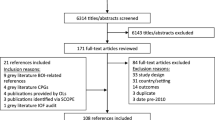Abstract
In the last decade, there have been a number of action plans published to highlight the importance of preventing osteoporosis and related fractures. In the province of Ontario Canada, the Ministry of Health provided funding for the Ontario Osteoporosis Strategy. The goal is to reduce morbidity, mortality, and costs from osteoporosis and related fractures through an integrated and comprehensive approach aimed at health promotion and disease management. This paper describes the components of the Ontario Osteoporosis Strategy and progress on implementation efforts as of March 2009. There are five main components: health promotion; bone mineral density testing, access, and quality; postfracture care; professional education; and research and evaluation. Responsibility for implementation of the initiatives within the components is shared across a number of professional and patient organizations and academic teaching hospitals with osteoporosis researchers. The lessons learned from each phase of the development, implementation, and evaluation of the Ontario Osteoporosis Strategy provides a tremendous opportunity to inform other jurisdictions embarking on implementing similar large-scale bone health initiatives.

Similar content being viewed by others
References
Curtis JR, Adachi JD, Saag KG (2009) Bridging the osteoporosis quality chasm. J Bone Min Res 24:3–7
Compston J (2004) Action plan for the prevention of osteoporotic fractures in the European Community. Osteoporos Int 15:259–262
Raisz LG, Elderkin AL, Schargorodski L, Hart T, Waldman C, King T, Noonan AS (2009) A call to action: developing and implementing a national action plan to improve bone health. Osteoporos Int 20:1805–1806
Jaglal SB, Weller I, Mamdami M, Hawker G, Kreder H, Jaakkimainen L, Adachi R (2005) Population trends in bone density testing, treatment and hip and wrist fracture rates: are the hip fracture projections wrong? JBMR 20(6):898–905
Giangregorio L, Papaioannou A, Crraney A, Zytaruk N, Adachi JD (2006) Fragility fractures and the osteoporosis care gap: an international phenomenon. Semin Arthritis Rheum 35:293–305
Papaioannou A, Kennedy CC, Ioannidis G, Gao Y, Sawka AM, Goltzman D, Tenenhouse A, Pickard L, Olszynski WP, Davison KS, Kaiser S, Josse RG, Kreiger N, Hanley DA, Prior JC, Brown JP, Anastassiades T, Adachi JD, CaMos Research Group (2008) The osteoporosis care gap in men with fragility fractures: the Canadian Multicentre Osteoporosis Study. Osteoporos Int 19(4):581–587
Siminoski K, Leslie WD, Frame H, Hodsman A, Josse RG, Khan A, Lentle BC, Levesque J, Lyons DJ, Tarulli G, Brown J (2005) Recommendations for bone mineral density reporting in Canada. Can Assoc Rad J 56:178–188
Waugh EJ, Lam MA, Hawker GA, McGowan J, Papaioannou A, Cheung AM, Hodsman AB, Leslie WD, Siminoski K, Jamal SA, Perimenopause BMD Guidelines Subcommittee of Osteoporosis Canada (2009) Risk factors for low bone mass in healthy 40-60 year old women: a systematic review of the literature. Osteoporos Int 20(1):1–21
Papaioannou A, Kennedy CC, Cranney A, Hawker G, Brown JP, Kaiser SM, Leslie WD, O’Brien CJM, Sawka AM, Khan A, Siminoski K, Tarulli G, Webster D, McGowan J, Adachi JD (2009) Risk factors for low BMD in healthy men age 50 years or older: a systematic review. Osteopor Int 20(4):507–518
Center JR, Bliuc D, Nguyen TV, Eisman JA (2007) Risk of subsequent fracture after low-trauma fracture in men and women. JAMA 297(4):387–394
Bogoch ER, Elliot-Gibson V, Beaton DE, Jamal SA, Josse RG, Murray TM (2006) Effective initiation of osteoporosis diagnosis and treatment for patients with a fragility fracture in an orthopaedic environment. J Bone Joint Surg Am 88(1):25–34
Dickson L, Cameron C, Hawker G, Ratansi A, Radziunas I, Bansod V, Jaglal S (2008) Development of a multidisciplinary osteoporosis telehealth program. Telemed e-Health 14(5):473–478
Jaglal SB, Hawker G, Bansod V, Salbach NM, Zwarenstein M, Carroll J, Brooks D, Cameron C, Bogoch E, Jaakkimainen L, Kreder H (2009) A demonstration project of a multi-component educational intervention to improve integrated post-fracture osteoporosis care in five rural communities in Ontario, Canada. Osteoporos Int 20(2):265–274
Giangregorio LM, Jantzi M, Papaioannou A, Hirdes J, Maxwell CJ, Poss JW (2009) Osteoporosis management among residents living in long-term care. Osteoporos Int 20(9):1471–1478
ACOVE Quality Indicators (2001) Ann Intern Med 135:653–667
Grossman JM, MacLean CH (2001) Quality indicators for the management of osteoporosis in vulnerable elders. Ann Intern Med 135:722–730
McKinley ED, Thompson JW, Briefer-French J, Wilcox LS, Weisman CS, Andrews WC (2001) Performance indicators in women’s health: incorporating women’s health in the health plan employer data and information set (HEDIS). Women’s Health Issues 2(1):46–58
National Committee for Quality Assurance (NCQA) (2005) HEDIS 2006. Health plan employer data and information set. Vol. 2, technical specifications. National Committee for Quality Assurance (NCQA), Washington DC, p 350
National Quality Forum www.qualityforum.org (accessed October 29, 2009)
Rubenstein LZ, Powers CM, MacLean CH (2001) Quality indicators for the management and prevention of falls and mobility problems in vulnerable elders. Ann Intern Med 135:686–693
Acknowledgements
We would like to thank the Ministry of Health in Ontario for their support of the Ontario Osteoporosis Strategy. Dr. Susan Jaglal holds the Toronto Rehabilitation Institute Chair at the University of Toronto. Dr. Gillian Hawker holds the F.M. Hill Chair in Academic Women’s Medicine. Dr. Alexandra Papiaoannou holds the Eli Lilly Canada Research Chair in Osteoporosis.
Conflicts of interest
None.
Author information
Authors and Affiliations
Consortia
Corresponding author
Rights and permissions
About this article
Cite this article
Jaglal, S.B., Hawker, G., Cameron, C. et al. The Ontario Osteoporosis Strategy: implementation of a population-based osteoporosis action plan in Canada. Osteoporos Int 21, 903–908 (2010). https://doi.org/10.1007/s00198-010-1206-5
Received:
Accepted:
Published:
Issue Date:
DOI: https://doi.org/10.1007/s00198-010-1206-5




